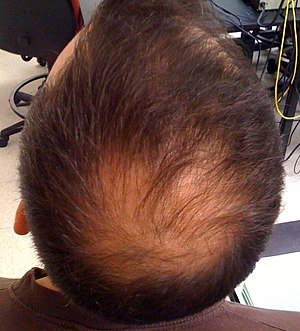Hair Aging
Hair loss, also known as alopecia, can be a distressing condition, affecting both men and women. While often considered a cosmetic issue, it can have psychological impacts and may sometimes signal underlying health concerns. In the context of longevity, understanding the causes and exploring preventative measures is key to maintaining not just the health of hair but also overall well-being.
Causes of Hair Loss
Genetic Factors
Hair loss often has a genetic component, known as androgenetic alopecia. This type of hair loss is commonly seen in both male pattern baldness and female pattern hair loss.
Ageing
As part of the natural aging process, hair follicles can shrink, leading to thinner, shorter hairs and eventually hair loss.
Hormonal Changes
Hormonal fluctuations, such as those occurring during menopause or pregnancy, can trigger hair loss. Thyroid disorders are also a common hormonal cause.
Nutritional Deficiencies
Deficiencies in key nutrients, including iron, protein, and vitamins, can lead to hair loss. Ensuring a balanced diet is crucial for hair health.
Medical Conditions and Treatments
Certain medical conditions, like alopecia areata and scalp infections, can cause hair loss. Treatments like chemotherapy can also lead to temporary hair loss.
Pathophysiology of Hair Loss
Hair Growth Cycle
Understanding hair loss requires knowledge of the hair growth cycle, which includes the anagen (growth phase), catagen (transitional phase), and telogen (resting phase). Disruptions in this cycle can lead to hair loss.
DHT and Hair Loss
Dihydrotestosterone (DHT), a derivative of testosterone, is a key player in androgenetic alopecia. It can shorten the growth phase and progressively miniaturize hair follicles.
Prevention Strategies
Diet and Nutrition
A diet rich in proteins, vitamins (especially biotin, vitamin D), and minerals is essential for hair health.
Stress Management
Chronic stress can contribute to hair loss. Techniques like meditation, exercise, and proper sleep can mitigate this effect.
Avoiding Harmful Hair Practices
Minimizing the use of heat styling tools, harsh hair products, and tight hairstyles can prevent hair damage and loss.
Regular Health Check-ups
Regular screenings for hormonal imbalances and nutrient deficiencies can help detect and address underlying causes of hair loss.
Treatment Options
Topical Treatments
Minoxidil is an over-the-counter treatment that can help in regrowing hair or slowing hair loss.
Prescription Medications
Finasteride and other prescription medications can be effective, especially in cases of androgenetic alopecia.
Hair Transplant Surgery
In cases where other treatments are ineffective, hair transplant surgery may be considered.
Alternative Therapies
Some individuals may find benefit in natural remedies or treatments like acupuncture, although these methods lack robust scientific support.
Conclusion
Understanding the multifaceted causes of hair loss and adopting a holistic approach towards prevention and treatment is vital in the context of longevity. Maintaining hair health is not only a matter of aesthetics but also a reflection of overall physical and mental well-being.
See Also
- Wikipedia - Hair loss
Todo
- 2021, Treatment options for androgenetic alopecia: Efficacy, side effects, compliance, financial considerations, and ethics [1]
References
- ↑ Nestor MS et al.: Treatment options for androgenetic alopecia: Efficacy, side effects, compliance, financial considerations, and ethics. J Cosmet Dermatol 2021. (PMID 34741573) [PubMed] [DOI] [Full text] BACKGROUND: Androgenetic alopecia (AGA) is the most common form of hair loss consisting of a characteristic receding frontal hairline in men and diffuse hair thinning in women, with frontal hairline retention, and can impact an individual's quality of life. The condition is primarily mediated by 5-alpha-reductase and dihydrotestosterone (DHT) which causes hair follicles to undergo miniaturization and shortening of successive anagen cycles. Although a variety of medical, surgical, light-based and nutraceutical treatment options are available to slow or reverse the progression of AGA, it can be challenging to select appropriate therapies for this chronic condition. AIMS: To highlight treatment options for androgenetic alopecia taking into consideration the efficacy, side effect profiles, practicality of treatment (compliance), and costs to help clinicians offer ethically appropriate treatment regimens to their patients. MATERIALS AND METHODS: A literature search was conducted using electronic databases (Medline, PubMed, Embase, CINAHL, EBSCO) and textbooks, in addition to the authors' and other practitioners' clinical experiences in treating androgenetic alopecia, and the findings are presented here. RESULTS: Although topical minoxidil, oral finasteride, and low-level light therapy are the only FDA-approved therapies to treat AGA, they are just a fraction of the treatment options available, including other oral and topical modalities, hormonal therapies, nutraceuticals, PRP and exosome treatments, and hair transplantation. DISCUSSION: Androgenetic alopecia therapy remains challenging as treatment selection involves ethical, evidence-based decision-making and consideration of each individual patient's needs, compliance, budget, extent of hair loss, and aesthetic goals, independent of potential financial benefits to the practitioners.
